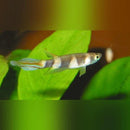Description
The Clown Killifish, scientifically known as Epiplatys annulatus, is a unique and colorful freshwater fish species that hails from the tropical regions of West Africa, particularly in areas with slow-moving or stagnant waters. This petite and visually captivating fish is highly regarded by dedicated hobbyists for its striking appearance and fascinating behavior, although it is important to note that it is not a true "killifish" but belongs to a different family called Nothobranchiidae.
Appearance: Clown Killifish are known for their vibrant and intricate coloration. Their bodies are slender and elongated, with striking patterns of bold and alternating vertical bars. These bars are typically black or dark brown and contrast beautifully against a base color that can range from bright red to orange, yellow, or even green, depending on their mood and breeding condition. Additionally, Clown Killifish boast a distinctive and eye-catching iridescent sheen that shimmers when exposed to light.
Behavior and Personality: Despite their small size, Clown Killifish exhibit engaging and lively behavior. They are active swimmers and are known for their occasional "sparring" displays, where males may engage in a brief territorial dispute by darting at each other. These displays, while intriguing, are generally harmless and rarely result in injury. Clown Killifish are also relatively peaceful and can be kept in community aquariums with other small, non-aggressive fish species.
Habitat and Care: To provide an ideal habitat for Clown Killifish, set up an aquarium with a minimum capacity of 10 gallons, though larger tanks are often preferred for ease of maintenance. Decorate the tank with plenty of aquatic plants and provide hiding spots using driftwood or rocks. Maintain a stable water temperature between 72°F to 78°F (22°C to 26°C) and a neutral to slightly acidic pH level (around 6.5 to 7.0).
Diet: Clown Killifish are carnivorous and primarily feed on small aquatic insects, worms, and other tiny invertebrates in their natural habitat. In captivity, they can be fed a diet of high-quality flake foods, micro pellets, and live or frozen foods such as daphnia, brine shrimp, and bloodworms to ensure they receive adequate nutrition.
Compatibility: These fish are generally peaceful and can coexist with other small, non-aggressive fish species that share similar water parameters. However, due to their small size, they may be vulnerable to harassment by larger or more aggressive tankmates. It's important to choose tankmates carefully and avoid housing them with fin-nipping or territorial fish.
Payment & Security
Your payment information is processed securely. We do not store credit card details nor have access to your credit card information.


